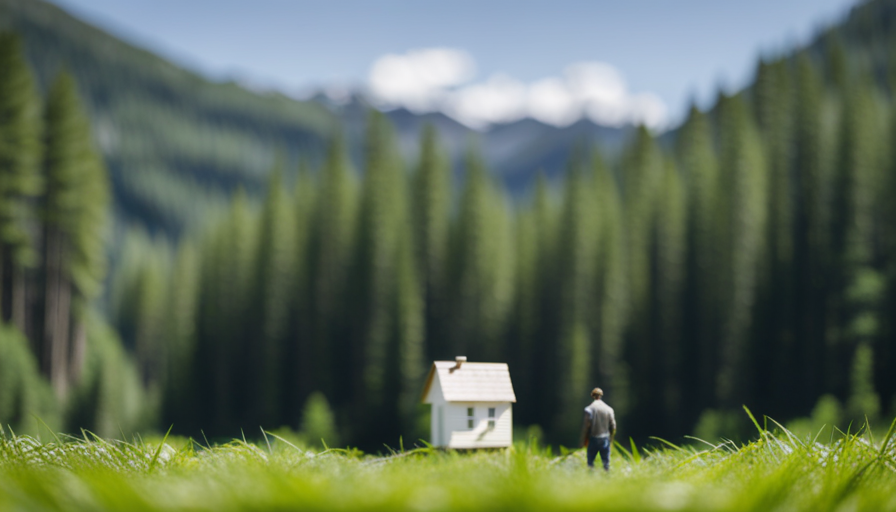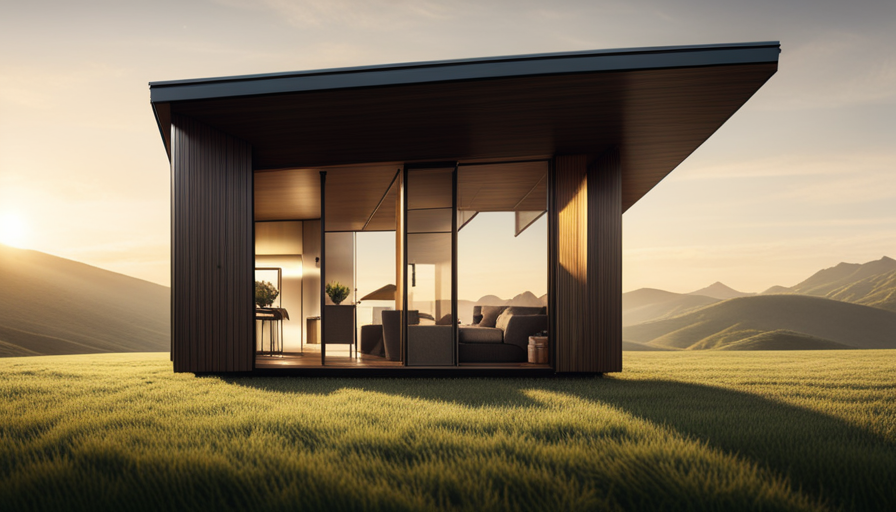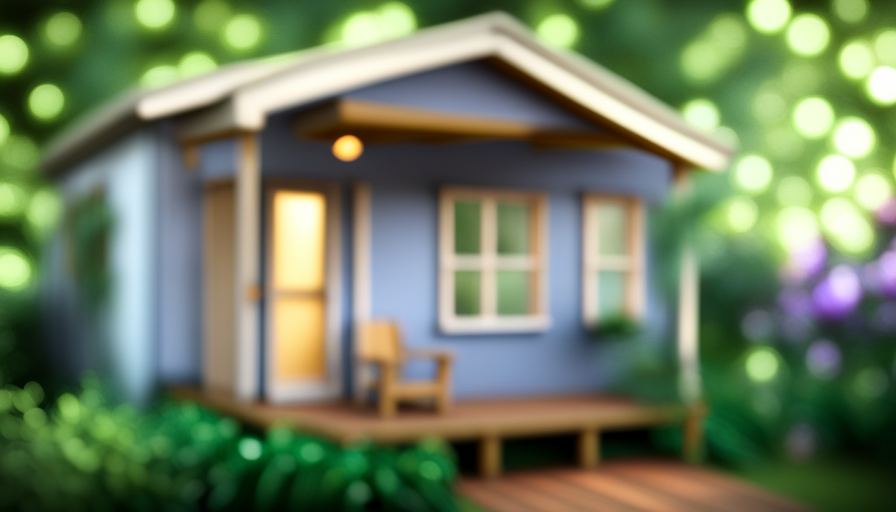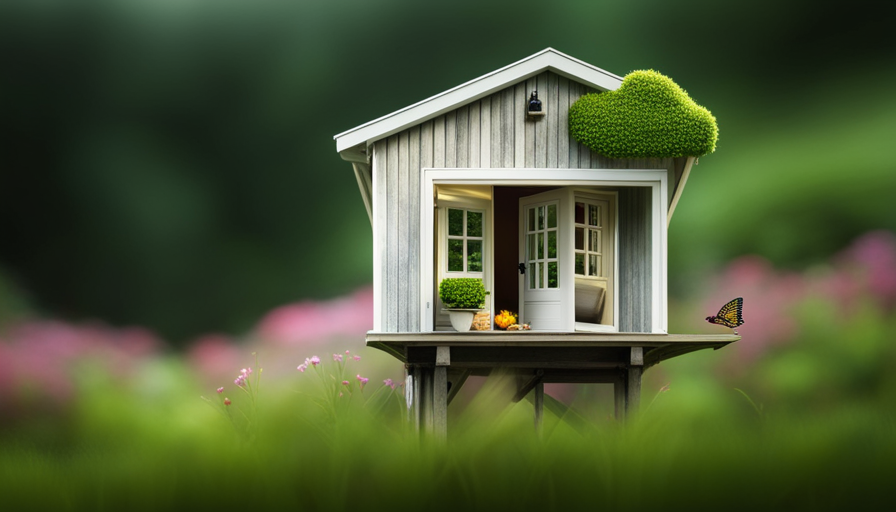Immerse yourself in the world of tiny houses, where grand aspirations of **freedom** and a minimalist lifestyle collide. This movement promises to liberate individuals from excessive belongings and financial burdens. But the question remains: how sustainable is living in a tiny house? Join me on a journey through the realm of tiny house living, as we explore the reasons why people either thrive in this unique lifestyle or opt out.
From financial considerations and budgeting, to designing and maximizing space, to the emotional and mental challenges that come with living in a small space, we will delve into every aspect of tiny house living.
We will also examine the sustainable living and environmental benefits, the importance of building and maintaining relationships within a tiny house community, and the legal and zoning considerations that can impact longevity.
Whether you are considering a tiny house adventure of your own or simply curious about this growing trend, join me as we uncover the secrets to long-term happiness and success in tiny house living.
Key Takeaways
- Financial planning and budgeting are essential for the longevity of living in a tiny house.
- Designing and maximizing space through multifunctional furniture and vertical storage solutions is crucial for a successful tiny house living.
- Addressing emotional and mental challenges such as feelings of confinement and claustrophobia by creating a sense of personal space and privacy is important for the well-being of tiny house dwellers.
- Living in a tiny house offers a sustainable and eco-conscious lifestyle, contributing to the reduction of environmental impact.
Factors That Influence Longevity in Tiny House Living
If you’re considering living in a tiny house, there are several factors that can influence how long you’ll be able to comfortably stay in this unique lifestyle. Factors affecting well-being in tiny house living play a significant role in determining the longevity of this choice.
One major factor is the impact of minimalism on tiny house longevity. Living in a tiny house requires a significant downsizing of possessions and embracing a minimalist lifestyle. This can have a positive impact on your well-being, as it promotes simplicity, reduces clutter, and fosters a sense of freedom. However, it’s important to recognize that minimalism may not be for everyone, and some individuals may struggle with the limited space and lack of personal belongings.
Another factor that affects longevity in tiny house living is the ability to adapt to a smaller living space. While some people thrive in the cozy and compact environment of a tiny house, others may feel confined and restricted. It’s crucial to assess your personal preferences and determine if you can comfortably adjust to the limited square footage and storage options.
Factors affecting well-being and the impact of minimalism on tiny house longevity are essential considerations when deciding to live in a tiny house. By understanding how these factors may influence your experience, you can make an informed decision about whether this lifestyle is suitable for you.
As we transition into the subsequent section about financial considerations and budgeting for tiny house living, it’s crucial to evaluate the monetary aspects of this lifestyle to ensure long-term sustainability.
Financial Considerations and Budgeting for Tiny House Living
When living in a tiny house, it’s crucial to carefully plan your finances and budget to ensure smooth sailing on the financial front. Financial planning is essential to make sure you can afford the initial costs of building or buying a tiny house, as well as the ongoing expenses of living in one.
It’s important to consider the cost of land, permits, materials, and labor if you decide to build your own tiny house. If you choose to buy a pre-built tiny house, you need to factor in the purchase price and any additional costs for customization or relocation. Additionally, you should budget for utilities, maintenance, and insurance.
To save money while living in a tiny house, you can employ various cost-saving strategies. These may include using energy-efficient appliances, installing solar panels, collecting rainwater for non-potable uses, and implementing smart home technology to monitor and control energy usage. You can also minimize expenses by adopting a minimalist lifestyle, reducing your consumption, and embracing sustainable practices such as composting and gardening.
By carefully planning your finances and implementing cost-saving strategies, you can create a sustainable and affordable lifestyle in a tiny house.
In the next section, we will explore the importance of designing and maximizing space in a tiny house.
Designing and Maximizing Space in a Tiny House
Creating an efficient and functional living space is essential to fully embrace the minimalist lifestyle of tiny house living. In order to maximize storage and make the most of the limited space, innovative furniture designs play a crucial role. Here are three key strategies for designing and maximizing space in a tiny house:
-
Multifunctional Furniture: Investing in furniture pieces that serve multiple purposes is a game-changer in a tiny house. For example, a sofa that can be transformed into a bed or a coffee table that doubles as a storage unit can save a significant amount of space.
-
Vertical Storage Solutions: Utilizing vertical space is a must in a tiny house. Installing floating shelves, wall-mounted organizers, and overhead storage compartments can help keep belongings organized and free up valuable floor space.
-
Built-In Features: Incorporating built-in features such as fold-down tables, hidden cabinets, and built-in seating can maximize space while maintaining a clean and clutter-free aesthetic.
By implementing these strategies, tiny house dwellers can create a functional and efficient living space that meets their needs.
However, living in a small space also comes with its own set of challenges, both emotional and mental. Transitioning into the subsequent section about the emotional and mental challenges of living in a small space, it’s important to address these aspects to ensure a well-rounded understanding of the tiny house lifestyle.
Emotional and Mental Challenges of Living in a Small Space
Navigating the emotional and mental challenges of residing in a compact living environment can be a transformative journey, requiring adaptability and a healthy dose of self-reflection. Living in a tiny house presents unique challenges to our emotional well-being and has a significant psychological impact. The limited space can lead to feelings of confinement and claustrophobia, making it crucial to find coping strategies to maintain a positive mindset.
One of the key factors in maintaining emotional well-being in a tiny house is creating a sense of personal space and privacy. This can be achieved through clever design choices such as utilizing curtains or dividers to separate different areas within the tiny house. Additionally, incorporating natural light and open windows can help combat feelings of being cramped and enhance one’s overall mood.
It is also important to recognize that living in a tiny house requires a shift in mindset and lifestyle. Downsizing possessions and embracing minimalism can be challenging, as it often involves letting go of sentimental items. However, this process encourages us to evaluate our priorities and focus on what truly brings us joy and fulfillment.
Transitioning to the subsequent section about sustainable living and environmental benefits of tiny houses, it’s worth noting that the emotional and mental challenges discussed here are part of the larger journey towards a more sustainable and eco-conscious lifestyle. By embracing the minimalist mindset and adapting to a smaller living space, individuals can contribute to reducing their environmental footprint and lead a more fulfilling life.
Sustainable Living and Environmental Benefits of Tiny Houses
Living in a compact, eco-friendly home offers a sustainable and fulfilling way of life. Tiny houses are built using sustainable construction techniques that minimize their environmental impact. They are often constructed with recycled or reclaimed materials, reducing the need for new resources.
Additionally, tiny houses are designed to be energy-efficient, with features such as solar panels and rainwater harvesting systems, allowing for off-grid living.
The environmental benefits of tiny houses are significant. They have a smaller carbon footprint compared to traditional homes, as they require fewer resources to build and maintain. The reduced space also encourages a minimalist lifestyle, leading to less consumption and waste. Furthermore, living in a tiny house promotes a closer connection to nature, as many tiny house owners choose to live in rural or natural settings.
Sustainable living and environmental benefits are key aspects of living in a tiny house. The use of sustainable construction techniques and the ability to live off-grid contribute to a reduced environmental impact. Furthermore, the smaller footprint and minimalist lifestyle associated with tiny houses promote a more eco-friendly way of living.
Transitioning to the next section, finding the right location for your tiny house is an important consideration in maximizing the benefits of this lifestyle.
Finding the Right Location for Your Tiny House
Choosing the perfect spot for your compact abode is like finding a hidden gem in a vast wilderness, where the harmony between your tiny home and its surroundings creates a picturesque haven.
When it comes to finding suitable land for your tiny house, there are a few key factors to consider. First and foremost, you’ll need to navigate zoning restrictions. Many areas have specific regulations regarding where tiny houses can be located, so it’s important to do your research and ensure that you’re in compliance with local laws.
Additionally, you’ll want to find a location that offers the amenities and resources you need, such as access to water, electricity, and waste disposal.
It’s also worth considering the overall vibe and community of the area you choose, as building and maintaining relationships in a tiny house community can be a valuable aspect of the lifestyle.
By carefully considering these factors, you can find the perfect spot to call home in your tiny house community, where you can build lasting connections and create a sense of belonging.
Building and Maintaining Relationships in a Tiny House Community
Imagine the joy of connecting with like-minded individuals who share your passion for simple living and creating a supportive community in your cozy haven. Building strong, supportive relationships in a tiny house community is essential for a fulfilling and sustainable lifestyle. Here are three ways to cultivate these relationships:
-
Embrace communal activities: Engaging in shared activities like gardening, cooking, or hosting movie nights fosters a sense of togetherness and strengthens bonds within the community. These activities provide opportunities for collaboration and create lasting memories.
-
Respect personal boundaries: Maintaining privacy and personal space in a shared tiny house environment is crucial. Establishing clear boundaries and communicating openly about individual needs and preferences ensures that everyone feels respected and comfortable. This balance between communal living and personal space helps to prevent conflicts and promotes harmonious relationships.
-
Foster open communication: Effective communication is the backbone of any successful community. Regular house meetings, where concerns can be addressed and ideas can be shared, create a space for open dialogue. It’s important to actively listen to one another, practice empathy, and find solutions together.
Building and maintaining strong relationships in a tiny house community requires effort and understanding. By embracing communal activities, respecting personal boundaries, and fostering open communication, you can create a supportive and harmonious living environment. Transitioning into the next section, adapting to changing needs and lifestyle transitions is another crucial aspect of tiny house living.
Adapting to Changing Needs and Lifestyle Transitions
Embracing flexibility and adjusting to new circumstances is key in ensuring that your tiny house community thrives amidst changing needs and lifestyle transitions. Adapting to new routines is essential as individuals within the community undergo various life changes.
Whether it’s starting a new job, welcoming a new member into the family, or even experiencing health challenges, being open to adjusting schedules and responsibilities is crucial for maintaining harmony within the community.
Navigating social dynamics is another aspect that requires adaptability. As people enter and leave the community, it’s important to embrace newcomers and ensure they feel welcome. Building new relationships and fostering a sense of belonging can help individuals adjust to their new surroundings and create a supportive environment.
Moreover, as lifestyle transitions occur, it’s important to communicate and address any potential conflicts that may arise. Open lines of communication and a willingness to compromise can help resolve differences and maintain a harmonious living environment.
Transitioning smoothly from one phase to another is essential for the long-term success of your tiny house community. By adapting to changing needs and embracing new routines, you can create a resilient and thriving community that can withstand any lifestyle transition.
As our needs and lifestyles change, it’s also essential to consider legal and zoning considerations for tiny house living.
Legal and Zoning Considerations for Tiny House Living
Navigating the legal and zoning considerations for living in a tiny house can be a complex but necessary step towards creating a sustainable and thriving community. Legal restrictions and zoning laws play a crucial role in determining where and how tiny houses can be built and occupied. It is important to research and understand these regulations before embarking on the tiny house lifestyle.
Legal restrictions vary from place to place, with some jurisdictions allowing tiny houses as permanent residences while others only permit them as temporary dwellings or accessory structures. Zoning laws dictate the specific areas where tiny houses can be located, such as designated tiny house communities or certain residential zones. These laws often outline minimum square footage requirements, setback distances, and utility connections.
Complying with legal and zoning considerations ensures that tiny house dwellers can live within the bounds of the law, avoiding potential fines or eviction. It also helps create a sense of stability and legitimacy for the tiny house movement, fostering acceptance and support from local communities.
Understanding and adhering to legal and zoning requirements is just one aspect of successful tiny house living. By following these regulations, individuals can then focus on creating long-term happiness and success in their tiny homes. Transitioning to the next section, it is important to consider some tips for maintaining a fulfilling and sustainable lifestyle in a tiny house.
Tips for Long-Term Happiness and Success in Tiny House Living
Achieving contentment and prosperity in the world of tiny living can be a challenge, but with the right mindset and a little creativity, I can turn my small abode into a cozy haven that feels like a little slice of heaven. Here are four tips for long-term happiness and success in tiny house living:
-
Cultivate and nurture long-term relationships: Living in a tiny house can be an opportunity to strengthen bonds with loved ones. With limited space, it becomes essential to prioritize quality time and meaningful connections. Engaging in open communication and shared activities can foster a sense of togetherness and support.
-
Embrace personal growth: Living in a tiny house encourages simplicity and minimalism. It provides an opportunity to declutter not only physical possessions but also mental and emotional baggage. I can focus on personal growth by practicing mindfulness, exploring new hobbies, and setting achievable goals. This self-improvement journey can lead to a greater sense of fulfillment and overall happiness.
-
Utilize outdoor spaces: Although the indoor space may be limited, there is often ample opportunity to enjoy the outdoors. I can transform my tiny house living experience by creating outdoor living areas, such as a cozy patio or a vibrant garden. These spaces can provide a sense of expansion and connection with nature.
-
Stay connected to the wider community: Living in a tiny house does not mean living in isolation. Engaging with the wider community can provide a sense of belonging and support. Participating in local events, volunteering, or joining tiny house communities can create opportunities for shared experiences and enriching relationships.
By implementing these tips, I can create a fulfilling and prosperous long-term experience in my tiny house.
Frequently Asked Questions
What are the legal requirements for living in a tiny house?
The legal requirements for living in a tiny house vary depending on the location and jurisdiction.
Zoning restrictions play a crucial role in determining where you can legally place your tiny house.
It is important to research and comply with the local building codes, permits, and regulations.
Additionally, some areas may require the tiny house to be connected to utilities, such as water and electricity.
It is advisable to consult with local authorities and professionals to ensure compliance with all legal requirements.
How do you find a suitable location to park or place your tiny house?
Finding a suitable location to park or place your tiny house can be a challenge. It’s important to consider zoning regulations when searching for a location. Different areas have different rules and restrictions regarding where you can park or place a tiny house.
Some areas may allow tiny houses on private property, while others may require them to be in designated communities. Researching local zoning regulations and reaching out to local authorities can help you find a suitable location that complies with the rules.
What are the challenges of maintaining relationships within a tiny house community?
Maintaining relationships within a tiny house community can be quite the adventure. Social dynamics are heightened when living in close quarters with others. It’s like a never-ending game of ‘Guess Who?’ as you navigate the intricacies of communal living.
From deciding whose turn it is to do the dishes to finding personal space amidst the shared walls, challenges abound. But hey, it’s all part of the tiny house experience, fostering patience, compromise, and the occasional impromptu dance party.
How do you adapt to changing needs and lifestyle transitions in a small space?
Adapting to changing needs and lifestyle transitions in a small space can be challenging, but it’s possible with careful planning and flexibility.
Here are some strategies to consider:
- Maximize storage solutions
- Utilize multi-purpose furniture
- Organize belongings efficiently
Lifestyle adjustments may include:
- Downsizing possessions
- Prioritizing essential items
- Developing a routine that accommodates the limited space
It’s important to continuously evaluate and adapt to ensure a comfortable and functional living environment in a tiny house.
Are there any tips for long-term happiness and success in tiny house living?
Achieving long-term satisfaction in tiny house living requires careful consideration of space utilization. One interesting statistic is that 68% of tiny house owners reported higher levels of happiness compared to traditional homeowners.
To maximize space, prioritizing multi-functional furniture and smart storage solutions is essential. Additionally, creating an efficient layout and incorporating natural light can contribute to a sense of well-being.
By embracing minimalism and simplifying one’s lifestyle, long-term happiness and success can be achieved in the tiny house lifestyle.
Conclusion
In conclusion, living in a tiny house can be a challenging yet rewarding experience. The juxtaposition of financial considerations and sustainable living creates a unique lifestyle that requires careful planning and adaptability.
While the emotional and mental challenges may be overwhelming at times, the sense of community and the ability to maximize space make it all worthwhile.
It’s important to consider legal and zoning considerations, as well as maintaining relationships within the tiny house community.
By embracing change and finding long-term happiness, one can truly thrive in the world of tiny house living.
Hi, I’m Emma. I’m the Editor in Chief of Tiny House 43, a blog all about tiny houses. While tree houses are often associated with childhood, they can be the perfect adult retreat. They offer a cozy space to relax and unwind, surrounded by nature. And since they’re typically built on stilts or raised platforms, they offer stunning views that traditional homes simply can’t match. If you’re looking for a unique and romantic getaway, a tree house tiny house might just be the perfect option.










